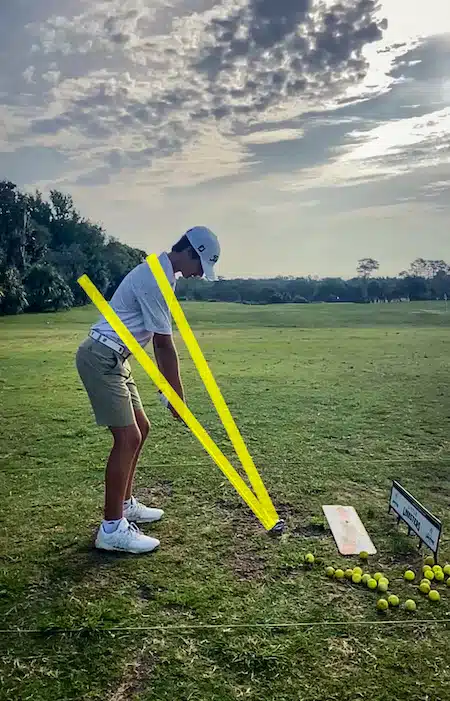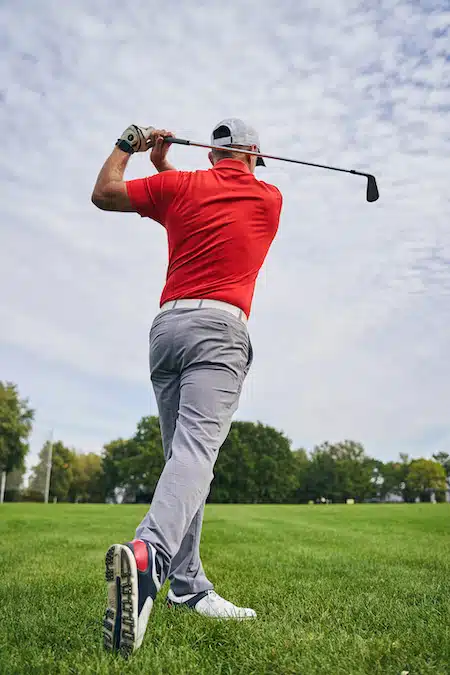What is a flat golf swing? Are there benefits to a flat swing? What problems can stem from a flat swing? We will examine these questions and many more about the flat golf swing.
A flat golf swing travels on a more horizontal plane than a standard swing. A strong grip, a shallow backswing, or a weak lead shoulder can cause this. Flat swings can have advantages such as increased clubhead speed and more control, but they can also be more difficult to master and more prone to topping.
In this article, I will discuss many questions surrounding the phrase, Flat Backswing. The topics will include the following:
- What is a Flat Swing in Golf?
- Pros and Cons of a Flat Backswing in Golf
- The main cause of a Flat Backswing in Golf
- How to Fix a Flat Swing in Golf
Let’s dive in and get you some answers on what a Flat Swing is and arm you with information about it!
What Is A Flat Swing?
A flat golf swing is more horizontal, around, or “under” the plane as it relates to a more standard swing plane. A more standard swing plane is based around an imaginary “V” created by two lines within a golfers setup position ar address.
The first, or bottom line, goes through your club’s shaft, up your arms, and out your lower back in a standard setup. The second, or top line, goes from the heel of your club at set up and up through your shoulders.
In the picture below, my student Nico is in his standard setup position. I drew the plane lines as described above in this picture for your reference.
In the following setup pictures, you can see that my student Harrison has a flat backswing. The club moves under the plane set by his setup at address.
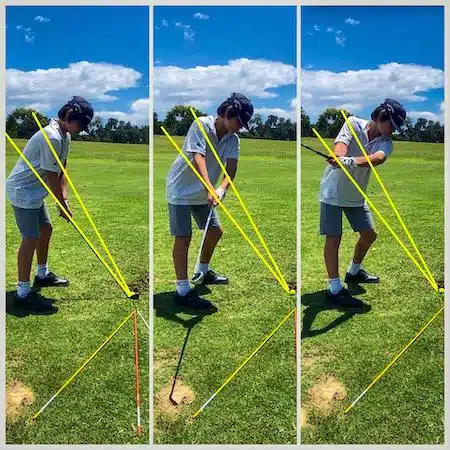
As I will get into a little later, a flat backswing or even a very steep backswing is not an issue by itself. The problems arise when the backswing does not match how the downswing is executed.
Golf is full of great players that are flat in the backswing. The following are some of golf’s best-known flat swingers. Fowler, Kuchar, Fitzpatrick, and Jon Rahm are all flat with their backswing.
Check this out: Tips For Short Golfers – Play Your Advantage
Pros and Cons of a Flat Swing
Here is a little secret about your backswing plane, whether flat, upright, or somewhere in between: your backswing plane really doesn’t matter! Seriously, it doesn’t! What matters is the match-up between your backswing plane and your downswing plane.
Your downswing plane matters the most in your golf swing. There is absolutely nothing wrong with a flat backswing if you can have a downswing that compliments it. With that in mind, let me review some pros and cons of a flat backswing.
Pros
-
A Flat Backswing Will Give You the Potential To Create More Speed, and Speed Creates Distance
Golf has become a game of distance, and whoever hits it the furthest tends to have the potential to score better. However, there is a lot more that goes into that hypothesis. Better players that hit it further can usually also control that speed and distance.
That is not always the case with longer hitters who are higher handicappers…in fact, that is often not the case.
-
A Flater Backswing Is a More Natural Feeling for Most
A golf swing is something that is supposed to be a rotational motion. So, with that thought in mind, a flatter swing back feels more natural for those learning the game and even more seasoned players.
-
A Flater Backswing Can Help Produce a Draw
Many golfers like the idea of being able to hit a draw. The right-to-left spin of a draw (for righties) helps create more distance, especially with clubs like a driver. When a draw shot lands on the ground, with that type of spin, a ball is more prone to roll out.
A flatter backswing can help golfers produce a draw if the downswing matches up.
Cons
-
A Flat Backswing Could Cause an Over-the-Top Downswing
An over-the-top path on the downswing is one of the most common issues those with flat backswings have. There is a tendency for those that are flatter going back to come over the top or over the plane on the downswing.
This move commonly causes golfers to hit pulled shots or big slices. This tends to happen because an inside swing path on the backswing requires a golfer to maintain that inside path on the downswing and rotate the body hard. That is a difficult thing for many to pull off.
The tendency for many that swing overly flat going back is to early extend with the hips on the downswing. That is because it is difficult to maintain the correct spine angle that long. The result is a swing plane that gets too steep or over the plane on the downswing.
-
A Flatter Backswing Can Make a Mess of a Golfer’s Impact Position
Another issue that tends to happen with a flat backswing and goes hand in hand with the previously listened con, the over-the-top downswing, is being able to square the clubface at impact. That fault happens as a result of that early extension issue mentioned above.
When this happens, and the club gets steep on the downswing, you have little room for the hands to work from the inside and correctly into the ball at impact. That room or space is necessary for the hands to have clear sailing moving into impact, allowing them to square the face up as it moves into the ball.
I teach most of my golfers to swing the club back a little more vertically on the backswing. This allows them to get a little shallower on the downswing, and maintain that, as they move through impact.
-
Can Cause Golfers to Roll The Face Open Going Back
Another widespread issue I see with those that get too flat going back in their swing is a rolling over of the forearm. When you roll the forearms as you go back, you tend to open the face of the club.
Once it happens going back, it is hard to get it squared back up correctly at the top of the backswing and, more importantly, on the downswing. Getting it squared back up is not impossible, but it takes some definite manipulation. You don’t want that to be just one more thing to remember. However, keeping things simple is essential in golf.
-
Can Cause the Dreaded and Nasty Shank To Happen
As alluded to, a good marriage between the backswing and downswing paths is critical. Issues can happen if you are too flat in your backswing and can’t maintain a similar path on the downswing.
While it is desirable to deliver the club from the inside on the downswing, there is much more that goes with that. You need to properly rotate the forearms and hands to square the clubface up at impact. If you are too flat going back, early extend with the body in the downswing due to being unable to maintain your spine angle, and get stuck with the hands as they move into impact, you can have one of the most dreaded shots in golf happen. That nasty, grotesque, mind-numbing shot called the shank.
At the end of the day, you want a more neutral swing going back and coming down from the top. Or, stay in your posture in the downswing and rotate your body correctly if you have a little flatter backswing. Again, for most, that is a tall task, but possible.
More from Golf Span: Golf Swing Sequence: Steps To Gain Distance & Accuracy
The Main Cause Of A Flat Backswing
From my 25-plus years of coaching the game, the one thing that causes a backswing that is too flat is a lack of understanding of how a golf swing works.
A proper golf swing requires a rotationally based movement of the upper and lower body throughout the swing. Ideally, the lower body, or hips, rotate approximately 45 degrees in the backswing. The upper body, or shoulders, rotate at roughly 90 degrees going back and up to the top of the swing.
While all that happens with our body, our hands must maintain a little different path from what our body is doing as it rotates back in the backswing. The hand path needs to follow this concept of the swing plane, as I explained in the photos earlier in this article.
That part is where golfers have problems. There needs to be more understanding about how the body is supposed to move and how the hands and club are supposed to move with the body.
The number one cause, by far, of a backswing that is too flat is moving the hands and club too far to the inside as the body rotates back. The hands and club need to work more down the target line going back during the initial takeaway. This is critical. As you return, the club and hands must stay in front of the chest.
Check out another one of my articles: Single Plane Golf Swing: Pros, Cons, How To, & Mistakes
How To Fix A Flat Swing
As noted previously, the number one cause of a flat backswing is when a golfer moves their hands and club too far to the inside as the body rotates back. As you return, the club and hands must stay in front of the chest.
To accomplish this, you need to make a good initial takeaway of the club as the body rotates back in the backswing. Below is how I work on this with my students.
What You Will Need:
- 5 Alignment Sticks
- Pool Noodle
- A 7 iron
- Basket of range balls
- Some tees
Step #1 Set Up Your Practice Station
First, you will want to set up your practice station on the range. To do so, follow these steps:
- Place an alignment stick behind where you will hit your practice balls from and direct it towards your intended target (see picture below).
- Place an alignment stick to the inside of the target line alignment stick, one in front of where you will hit balls from, and one to the outside of the front target alignment stick (see picture below).
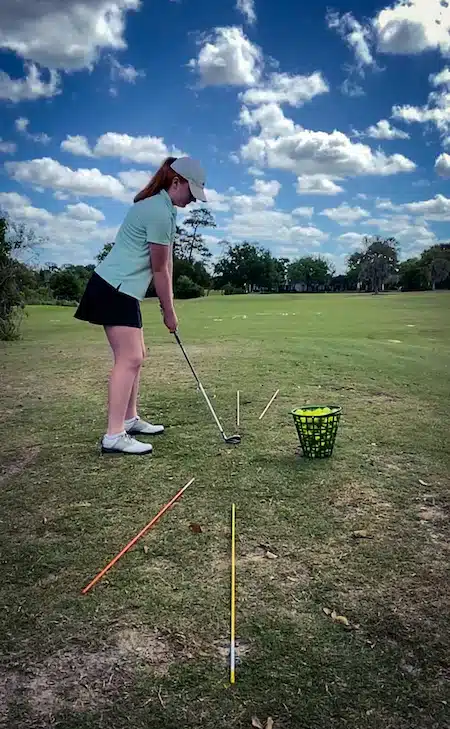
- Stick an alignment stick in the ground vertically, behind the target alignment stick on the ground. Place the pool noodle over that alignment stick (see picture below).
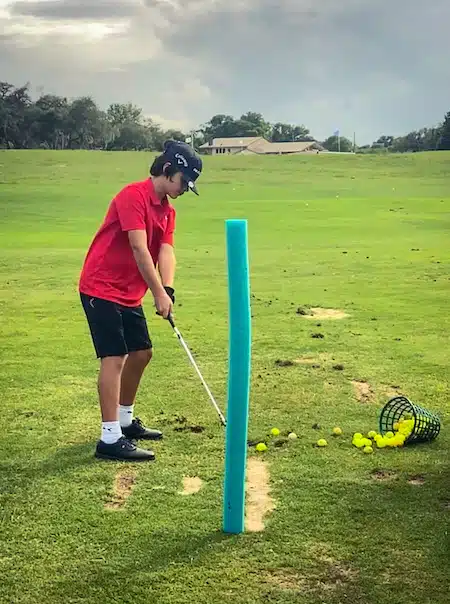
- Tee up the balls you are hitting directly in line with the target alignment sticks and the pool noodle. Tee the balls very low since you are hitting with a seven iron.
Step #2 Make Sure You Are Set Up Well at Address
Make sure you are set up in a good golf posture and aligned properly with your target. Clicking those two links will take you to some great articles on this topic right here on Golf Span!
Read also: Drills With Alignment Sticks
Step #3 Rehearse Several Backswings Using Your Station Set-Up
Your objective is to practice making a correct initial takeaway that does not move to the inside as you rotate your body back in the backswing. The alignment stick on the ground and the pool noodle remind you that the club head needs to move down the target line in the takeaway.
Step #4 Start to Make Swings and Hitting Shots
With your takeaway in mind, start making swings and hitting shots. Keep your hands and the club in front of you on the backswing. Use the alignment sticks on the ground to the inside of the target line alignment stick in the back, and the one to the outside of the target line stick in the front, as guides for your swing path on the downswing.
And another one: How to Hit a Golf Ball Straight: 10 Tips
FAQ
Is It Bad To Have A Flat Golf Swing?
Not necessarily, no. If a golfer can maintain a similar swing plane on the downswing, then there is nothing wrong with a flat backswing. However, it is difficult for most golfers to sustain that while maintaining their posture. Losing your posture on the downswing can cause early extension, leading to many issues.
Is A Shallow Or Steep Swing Better?
It is hard to say one is better than the other. Ideally, a more neutral swing plane is best. With that said, a shallower or steeper swing plane can have benefits. The potential problems arise when a backswing and downswing plane don't complement each other, regardless of if a swing is shallow or steep.
Does a Flat Swing Cause a Slice?
A flat backswing very often causes a slice. Staying in your posture and rotating correctly on the downswing is critical for those with flat backswings to hit good shots. That is a difficult task for most; many tend to come over the top on the downswing. That flat backswing and an over-the-top downswing are the root causes of most slices.
Final Thoughts
A flat backswing is more under the standard swing plane, created when a golfer sets up to the ball. By itself, a flatter backswing is not an issue. The problem for many that are flatter is they tend to get stuck on the downswing due to early extension. That early extension happens because it is challenging to maintain proper posture on the downswing when the club gets stuck behind you. And that is exactly what happens when golfers get too flat on the backswing…the club gets behind them.
Working on a better takeaway is a big part of being able to swing the club back much more neutral and less flat.
Brendon is Class A PGA Professional and founded Little Linksters, LLC, and its nonprofit arm, the Little Linksters Association for Junior Golf Development. He won 25+ prestigious industry honors, including the 2017 PGA National Youth Player Development Award. He graduated from the PGA of America Management Program and has a handicap index of 7.8.
He has played golf for over 40 years and currently plays twice a month at the Eagle Dunes Golf Club near Sorrento, Florida. He loves Srixon clubs and plays a ZX5 driver with Z 585 irons. He's written over 60 articles on GolfSpan and specializes in sharing tips to improve your golf game. You can connect with Brendon at LinkedIn, X, IG, FB, his website, or BrendonElliott@pga.com.
- Best score: 69
- Favorite driver: Srixon ZX5
- Favorite ball: Srixon Z Star
- Favorite food at the turn: Turkey and cheese on white
